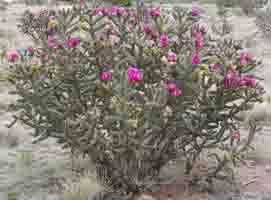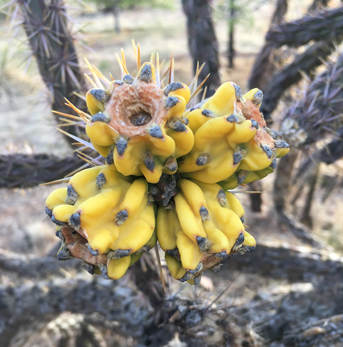 |
 |
 |
The plant w/flowers |
The flowers |
The fruit |
Description
"The above-ground part consists of much-branched cylindrical stems, the end joints being about 3 cm (1.2 in) in diameter. The joints, unlike those of some chollas, are hard to detach. The stems are highly tubercular (lumpy)[6] with a pattern of long oval lumps. A typical height is about 1 m (3 ft), but exceptionally it can grow to 4.6 m (15 ft) with a "trunk" diameter of 25 cm (9.8 in).[7] The width is often similar to or somewhat greater than the height. The stems are armed with clusters of up to about 10 red to pink[6] spines, which may be 3 cm (1.2 in) long[6] and are barbed and sharp enough to easily penetrate leather gardening gloves.[8] The stems and fruits also have many spines or "glochids" about 1 mm (0.04 in) long[6] that can detach and stick in the skin.
There are two kinds of stems or "cladodes": long plagiotropic, bearing flowers at the ends and falling off after a few years, and long orthotropic, primarily serving for support and transport and staying on the plant. Plagiotropic stems grow in a star- or crown-like pattern around a central orthotropic stem.[9] This species blooms in late spring or early summer. The flowers are purple or magenta, rarely rose-pink, about 5 cm (2.0 in) wide.[6] The fruits are yellowish, tubercular like the stems,[6] and shaped something like the frustum of a cone, with a hollow at the wide end where the flower fell off; they are often mistaken for flowers. The plant retains them all winter. They are dry and not tasty, though the Indians of Arizona and New Mexico are said to have eaten them.[7]
In addition to sexual reproduction, the tree cholla reproduces when stem joints fall to the ground and take root. Thus this species spreads and its spread is hard to control, especially where animals defecate seeds and carry stem joints stuck to their hide some distance from the parent plant. (Some cows, "cholla eaters", learn to eat cholla fruits despite the pain.) "Waves of invasion" typically occur four or five years after drought combined with grazing, probably because this combination exposes soil on which the stem joints can take root.[9]" (Wikipedia)
Ethnobotanical Uses
Food:
"(Acoma) Young joints split lengthwise, dried, and stored for winter use. Joints roasted and eaten. (Apache, White Mountain) Fruit dried for winter use. Fruit eaten raw or stewed. (Keres, Western) Roasted joints used for food during times of famine. (Papago) Eaten as greens in summer. (Tewa of Hano) Fruits boiled and eaten with sweetened cornmeal porridge." (Moerman 367)
"Historically, cholla is said to have been a famine food. The dethorned joints, flower buds, and fruit were all eaten, but only in time of great need. However, it may have been a common but forgotten staple. A 1915 record at Zuni relates that the fruit was eaten raw and stewed or dried for winter use. The dried fruit was ground into a flour, mixed with parched cornmeal, and made into a mush.
Nowadays, only the buds of this plant tend to be mentioned in cooking recipes." (Dunmire and Tierney 142)
Medicine:
"The brilliant magenta flowers are made into a tea and taken as a diuretic." (Moore 65)
"(Keres, Western) Ground needle coverings made into a paste and used for boils. Dried stem pith used for earache and running ear. Thorn coverings eaten by men in times of war to make them tough." (Moerman 367)
"Drink a tea made from the roots to break up and dissolve kidney stones." (Oscar from Oscars Tree Service, Santa Fe, NM)
Other Uses:
"These are sometimes gathered for canes, picture frames, or as souvenirs; and this probably accounts for its being called cane cactus.
After a particularly bad forage year, ranchers burn off its spines so that their stock may feed on the green stalks.
New Mexicans sometimes use it as a hair tonic. The roots are soaked in cold water for three or four days. Then, to check falling hair and to stimulate growth, the head is first shampooed and afterward rinsed with the infusion." (Moore 65)
"(Keres, Western) Thorns used as sewing material and for tattooing. Dried woody stems used for candles and torches before the presence of other forms of lighting. Red flowers used as an indicator of when to plant beans." (Moerman 367)
Internet Resource